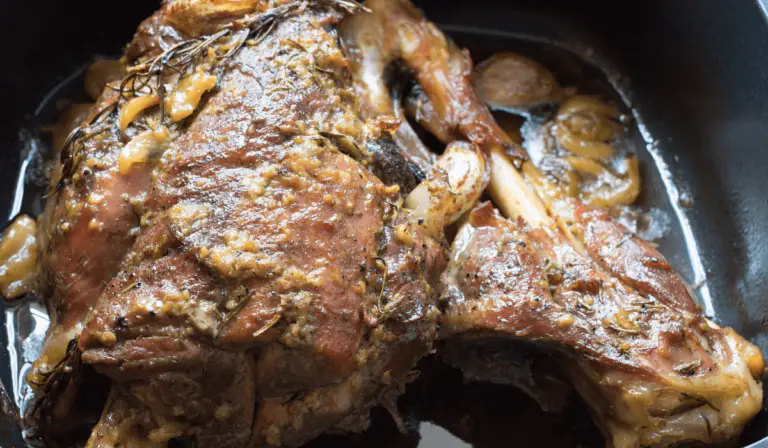Lamb Leg Steak Recipe: A Delightful Oven-Cooked Experience
Embark on a culinary journey with our Lamb Leg Steak Recipe, designed to bring out the best in this succulent cut of meat. In this guide, we’ll walk you through the steps to create an oven-baked lamb leg steak that’s not only tender and flavorful but also easy to prepare. Perfect for both novice cooks and seasoned chefs, this recipe promises to be a delightful addition to your cooking repertoire.
Introduction to Lamb Leg Steak
Lamb leg steak is a versatile and flavorful cut of meat, perfect for a range of culinary styles. Cooking lamb in the oven brings out its rich flavors and ensures a tender, juicy result. Understanding the cut is crucial for achieving the best cooking outcomes.
Benefits of Cooking Lamb in the Oven

Oven-cooking lamb has several advantages:
- Even Cooking: The oven provides consistent heat, ensuring the lamb cooks evenly.
- Flavor Enhancement: Slow cooking in the oven enhances the lamb’s natural flavors.
- Convenience: Oven cooking is hands-off, giving you time to prepare sides or sauces.
For more insights on the benefits of marinating meat, including lamb, visit Understanding the Benefits of Marinating.
Understanding the Cut: Lamb Leg Steak
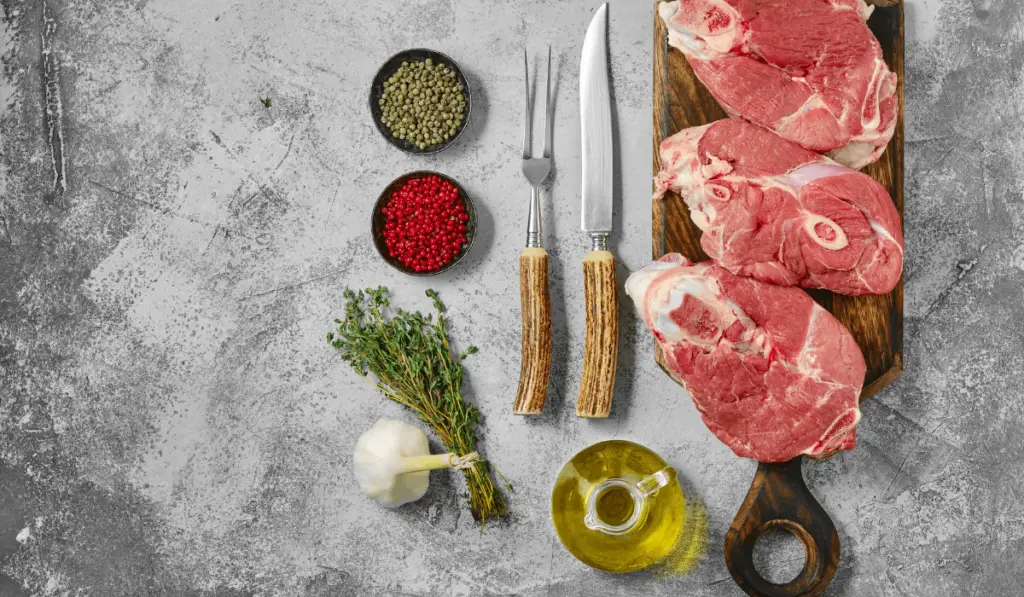
Lamb leg steak is cut from the leg of the lamb. It’s known for its tenderness and flavor, making it an excellent choice for oven cooking. When selecting lamb leg steak, look for cuts that are pinkish-red in color with a moderate amount of fat.
Certainly! Here’s a detailed guide on selecting the right ingredients for preparing a delicious lamb leg steak, emphasizing the importance of each component in enhancing the dish’s overall flavor.
Selecting the Right Ingredients for Lamb Leg Steak
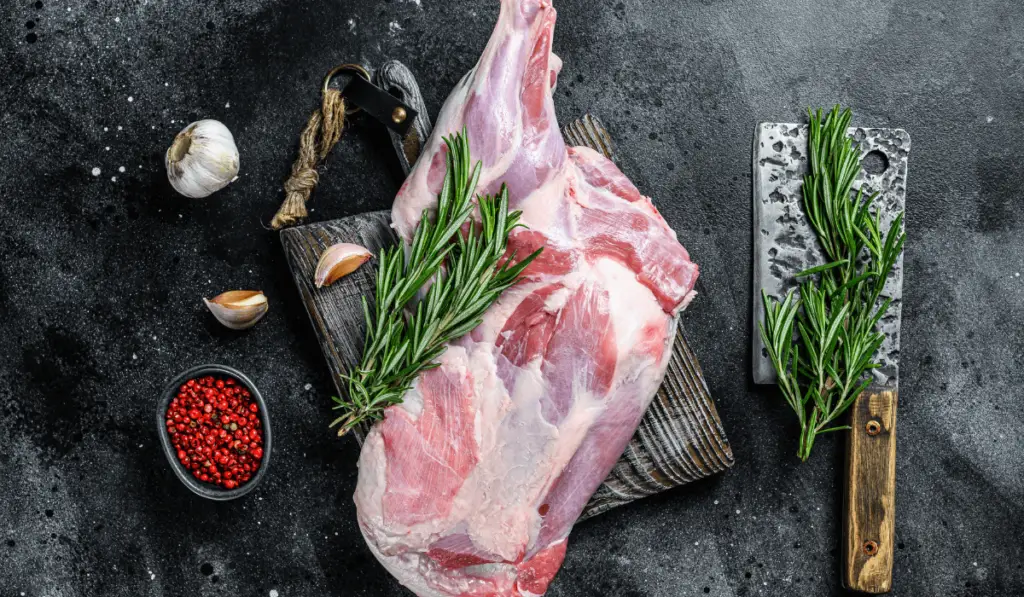
Creating a mouthwatering lamb leg steak starts with choosing the right ingredients. Each component plays a crucial role in bringing out the best in your dish. Here’s what you’ll need and why each ingredient matters:
Lamb Leg Steak
- Quality Matters: Look for fresh, high-quality lamb leg steak. The meat should have a pinkish-red color with some marbling for flavor and tenderness.
- Thickness: Consider the thickness of the steak. A thicker cut (about 1 to 1.5 inches) is ideal for achieving a nice sear on the outside while remaining tender and juicy inside.
Olive Oil
- Flavor and Cooking: Olive oil not only adds flavor but also helps in cooking. It’s ideal for marinating and searing the lamb.
- Choose the Right Type: Extra virgin olive oil is preferred for its flavor and health benefits. However, for high-heat cooking, a light or refined olive oil is more suitable due to its higher smoke point.
Fresh Herbs (Rosemary or Thyme)
- Herbal Aromatics: Fresh herbs like rosemary or thyme complement the rich flavor of lamb beautifully.
- Fresh vs. Dried: Fresh herbs are preferred for their vibrant flavor, but if unavailable, dried herbs can be used in a pinch (use one-third the amount of fresh).
Garlic
- Flavor Enhancer: Garlic adds a depth of flavor to the lamb. It can be used in the marinade or as a rub.
- Preparation: Use freshly minced or crushed garlic for the best flavor. Garlic powder can be an alternative, but fresh is always best.
Salt and Pepper
- Seasoning: Salt and pepper are essential for seasoning the lamb. They enhance the natural flavors of the meat.
- When to Season: Season the lamb just before cooking to prevent drawing out moisture. If marinating, include salt and pepper in the marinade.
By carefully selecting each of these ingredients, you ensure that your lamb leg steak will be flavorful, tender, and delicious. The right balance of these elements will bring out the best in your lamb dish, making it a memorable meal.
Certainly! Here’s a detailed guide on how to properly marinate lamb leg steak, emphasizing the importance of each step in enhancing the flavor and tenderness of the meat.
Preparation: Marinating the Lamb Leg Steak
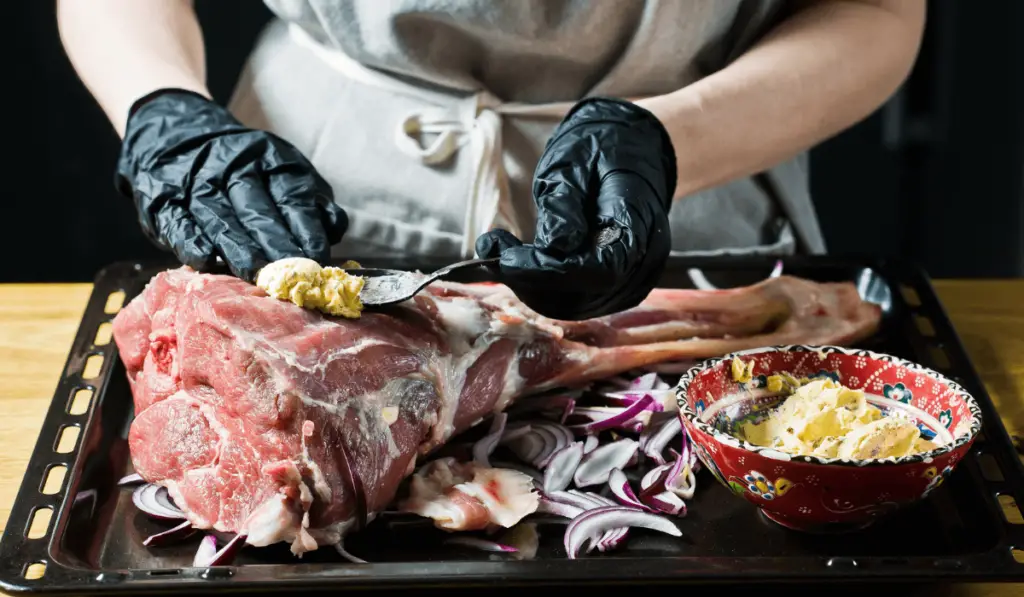
Marinating is a crucial step in preparing lamb leg steak, as it infuses the meat with additional flavors and helps tenderize it. Here’s how to create an effective marinade and use it to prepare your lamb for cooking:
Creating the Marinade
- Combine Olive Oil, Crushed Garlic, and Herbs:
- Olive Oil: Use about ¼ cup of olive oil as the base of your marinade. Olive oil helps to carry the flavors of the other ingredients and keeps the lamb moist during cooking.
- Crushed Garlic: Add 2-3 cloves of crushed garlic for a robust flavor. Garlic not only adds depth to the taste but also complements the natural flavor of the lamb.
- Herbs: Incorporate a tablespoon of fresh herbs like rosemary or thyme. These herbs are classic pairings with lamb and offer a fresh, aromatic quality to the meat.
Marinating the Lamb
- Season the Lamb with Salt and Pepper:
- Before applying the marinade, season the lamb leg steak generously on both sides with salt and pepper. This initial seasoning helps to enhance the meat’s natural flavors.
- Coat the Lamb in the Marinade:
- Place the lamb in a shallow dish or a resealable plastic bag.
- Pour the marinade over the lamb, ensuring it’s well-coated on all sides.
- If using a bag, seal it and gently massage the marinade into the meat.
- Refrigerate:
- Refrigerate the marinating lamb for at least 2 hours. This time allows the flavors to penetrate and tenderize the meat.
- For a more profound flavor, you can marinate the lamb overnight. However, be cautious not to over-marinate, as the meat can become too soft and lose its texture.
Additional Tips
- Turn the Meat Occasionally: If marinating in a dish, turn the lamb halfway through the marinating time to ensure even flavor absorption.
- Room Temperature Before Cooking: Remove the lamb from the refrigerator about 30 minutes before cooking to let it come to room temperature. This ensures more even cooking.
By following these steps, your lamb leg steak will be perfectly marinated, enhancing both its flavor and tenderness, and ready for cooking to perfection.
Oven Cooking Method
Follow these steps for a perfectly cooked lamb leg steak:
- Preheat the oven to 375°F (190°C).
- Place the marinated lamb on a roasting tray.
- Roast for 20-25 minutes for medium-rare, or adjust according to preference.
- Let the lamb rest for 10 minutes before slicing.
Alternative Cooking Methods for Lamb Leg Steak
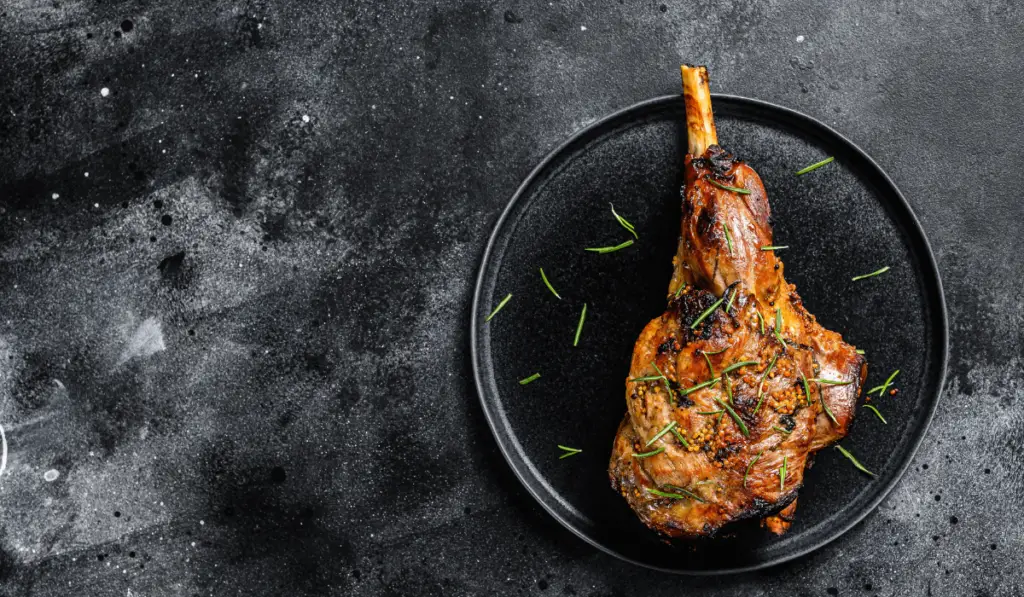
While oven cooking is a popular method for preparing lamb leg steak, exploring alternative cooking techniques can introduce new flavors and textures to this succulent cut of meat. Grilling and pan-searing are two excellent methods that bring out different aspects of the lamb’s natural taste.
Grilled for a Smoky Flavor
- Preparation: Before grilling, ensure your lamb leg steak is at room temperature. This helps it cook more evenly.
- Marinade: A marinade can add extra flavor to the lamb. Ingredients like garlic, rosemary, and olive oil not only enhance taste but also help in forming a delicious crust.
- Grilling Technique: Preheat your grill to a high temperature. Place the lamb steaks on the grill and cook for about 4-5 minutes on each side for medium-rare, depending on the thickness of the steak.
- Smoky Touch: Grilling imparts a distinctive smoky flavor to the lamb, which is difficult to replicate with other cooking methods.
- Resting: Allow the lamb to rest for a few minutes after grilling. This helps the juices redistribute, ensuring a moist and flavorful steak.
Pan-Seared for a Crispy Exterior
- Skillet Choice: Use a heavy skillet, preferably cast iron, for the best heat retention and even cooking.
- High Heat: Preheat the skillet over high heat. The high temperature is key to achieving a crispy, caramelized crust.
- Searing: Add a small amount of oil to the skillet and place the lamb steak in the pan. Sear for about 3-4 minutes on each side for medium-rare. The goal is to develop a rich, golden-brown crust on the surface.
- Butter Basting: For added flavor, you can baste the steak with butter, garlic, and fresh herbs in the final minutes of cooking.
- Resting: Similar to grilling, let the lamb rest after pan-searing to allow the juices to settle.
Both grilling and pan-searing offer unique ways to enjoy lamb leg steak. Grilling provides a smoky flavor perfect for outdoor cooking and summer barbecues, while pan-searing creates a delectable crust for a more indulgent experience. Whichever method you choose, these cooking techniques are sure to bring out the best in your lamb leg steak.
Serving Suggestions for Lamb Leg Steak
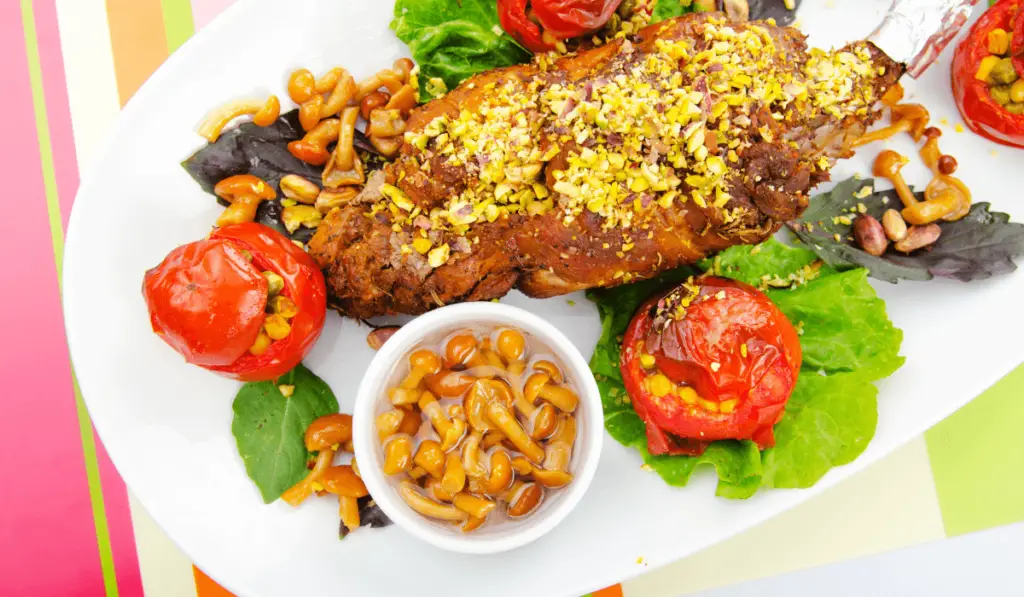
When it comes to serving lamb leg steak, the right side dishes can elevate the meal, balancing the rich flavors of the lamb with a variety of textures and tastes. Here are some classic and delicious options:
Roasted Vegetables
- Variety is Key: Choose a mix of vegetables like carrots, bell peppers, zucchini, and asparagus. The variety adds color and different flavors to your plate.
- Seasoning: Toss the vegetables in olive oil, salt, pepper, and herbs like rosemary or thyme to complement the lamb’s flavor.
- Roasting: Spread the vegetables on a baking sheet and roast in the oven until they are tender and slightly caramelized. This brings out their natural sweetness, offering a delightful contrast to the savory lamb.
Mashed Potatoes
- Creamy Texture: Mashed potatoes provide a smooth and creamy texture that pairs wonderfully with the tender lamb.
- Flavor Enhancements: Add butter, cream, and a hint of garlic or chives to the potatoes for extra richness and flavor.
- Preparation Tip: For the best texture, use starchy potatoes like Russets or Yukon Golds, and mash them until they are smooth and fluffy.
A Fresh Salad
- Light and Refreshing: A fresh salad can lighten the overall meal, offering a crisp and refreshing counterpoint to the hearty lamb.
- Ingredients: Combine mixed greens, cherry tomatoes, cucumber, and red onion. Add some feta cheese or olives for a Mediterranean twist.
- Dressing: A simple vinaigrette made with olive oil, lemon juice, salt, and pepper enhances the salad without overpowering the main dish.
These side dishes not only complement the flavors of the lamb leg steak but also provide a well-rounded, nutritious meal. Each component brings its own unique taste and texture, creating a harmonious and satisfying dining experience.
Wine Pairing
A robust red wine, like a Shiraz or Merlot, pairs beautifully with lamb. For a detailed guide, check out Expert Wine Pairing for Lamb Dishes.
Storage and Reheating Tips

Proper storage and reheating are crucial for enjoying your lamb leg steak leftovers while ensuring they remain delicious and safe to eat. Here are some tips to help you preserve the quality of your cooked lamb.
Storing Leftover Lamb Leg Steak
- Cool Down: Allow the lamb steak to cool to room temperature before storing. However, avoid leaving it out for more than 2 hours to prevent bacterial growth.
- Airtight Container: Transfer the lamb into an airtight container. This helps to retain moisture and prevent the steak from absorbing odors from other foods in the fridge.
- Refrigeration: Store the airtight container in the refrigerator. Properly stored, cooked lamb can last for 3 to 4 days.
Reheating Lamb Leg Steak
- Oven Reheating:
- Preheat your oven to 350°F (175°C).
- Place the lamb in an oven-safe dish and add a few tablespoons of broth or water to help maintain moisture.
- Cover the dish with aluminum foil to prevent drying out.
- Heat for about 10-15 minutes or until the internal temperature reaches 165°F (74°C).
- Microwave Reheating:
- Place the lamb in a microwave-safe dish.
- Cover the dish with a microwave-safe lid or plastic wrap to trap steam and moisten the meat.
- Reheat on medium power in short intervals of 30 seconds, checking regularly to avoid overheating.
- Continue until the lamb is heated through.
Additional Tips
- Avoid Repeated Reheating: Reheat only the amount of lamb you plan to eat. Repeated reheating can dry out the meat and promote bacterial growth.
- Slicing Thinly: If the lamb steak is thick, consider slicing it thinly before reheating. This ensures more even warming.
- Retaining Juiciness: Adding a little broth or water during reheating can help to keep the lamb moist.
By following these storage and reheating tips, you can enjoy your lamb leg steak leftovers while preserving their taste and texture as much as possible. Remember, gentle reheating is key to maintaining the quality of the meat.
Common Mistakes to Avoid with Lamb Leg Steak

Cooking lamb leg steak to perfection involves more than just following a recipe. It’s also about avoiding certain pitfalls that can compromise the quality of your dish. Here are some common mistakes to be aware of:
Overcooking
- Understanding Doneness: Lamb is best enjoyed when cooked to medium-rare or medium. This ensures the meat is tender and juicy.
- Use a Meat Thermometer: To avoid overcooking, use a meat thermometer. Medium-rare is achieved at an internal temperature of 145°F (63°C), and medium is around 160°F (71°C).
- Keep in Mind the Carryover Cooking: Remember that the meat will continue to cook slightly after being removed from the heat source due to carryover cooking.
Skipping the Resting Time
- Importance of Resting: After cooking, it’s crucial to let your lamb rest for about 10 minutes. This allows the juices to redistribute throughout the meat, resulting in a more flavorful and moist steak.
- Cover to Retain Heat: Cover the lamb loosely with foil during this time to keep it warm.
Over-marinating
- Balancing Flavors: While a good marinade can enhance the flavor of lamb, marinating for too long can overpower the natural taste of the meat.
- Recommended Marinating Time: Generally, 2 to 4 hours is sufficient for lamb leg steak. Avoid marinating for more than 24 hours.
- Choosing the Right Ingredients: Use a balanced mix of acids, oils, and herbs/spices in your marinade to complement, not mask, the lamb’s flavor.
By avoiding these common mistakes, you can ensure your lamb leg steak is cooked to perfection, retaining its natural juiciness and flavor. Remember, the key to a great lamb dish lies in the details of preparation and cooking.
Nutritional Information
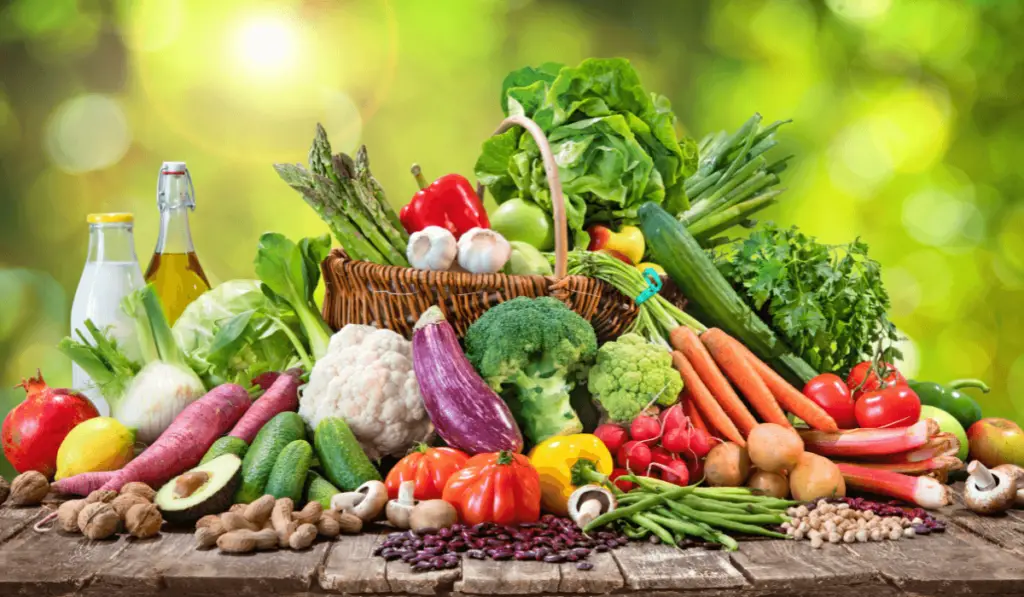
Lamb is a good source of protein, vitamins, and minerals. It’s particularly rich in vitamin B12 and iron.
FAQs
- What is the best way to cook lamb leg steak in the oven? Preheat the oven to 375°F and roast the marinated lamb for 20-25 minutes.
- How long should lamb leg steak be marinated? At least 2 hours, but not more than 24 hours.
- Can lamb leg steak be cooked from frozen? It’s best to thaw it first for even cooking.
- What are some good side dishes to serve with lamb leg steak? Roasted vegetables, mashed potatoes, or a fresh salad.
- How do you know when lamb leg steak is cooked to the desired doneness? Use a meat thermometer: 145°F for medium-rare.
In conclusion, cooking lamb leg steak in the oven is a simple yet rewarding culinary adventure. By following these guidelines, you can create a delicious, restaurant-quality meal right in your own kitchen. For more lamb recipes, explore our collection of Lamb Shoulder Steak Recipes, offering a variety of ways to enjoy this succulent meat.

